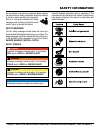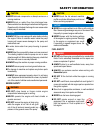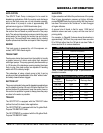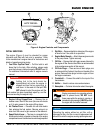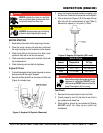
PAGE 14 — QP4TZT10P/TMP16F/TMPXF TRASH PUMP • OPERATION & PARTS MANUAL — REV. #1 (08/29/11)
GENERAL INFORMATION
APPLICATION
The QP4TZ Trash Pump is designed to be used for
dewatering applications. Both the suction and discharge
ports on the trash pump use a 4-inch diameter opening,
which allows it to pump at a rate of approximately 526
gallons/minute (gpm) or 2,000 liters/minute (lpm).
Trash or self-priming pumps are designed to purge air from
the suction line and create a partial vacuum in the pump
body. The reduced atmospheric pressure inside the pump
allows water to flow through the suction line and into the
pump body. The centrifugal force created by the rotating
impeller pressurizes the water and expels it from the pump.
ENGINE
This trash pump is powered by a 9.9 horsepower, air-
cooled, HATZ 1B40 diesel engine.
TRASH PUMP
Trash pumps derive their name from their ability to handle
a greater amount of debris and solids than standard
centrifugal pumps. This pump generally handles solids up
to 1/2 the size of the discharge opening making them less
likely to clog. Also trash pumps are capable of handling
water with 25% solids by weight.
The advantage of using a trash pump is that it can be
quickly and easily disassembled in the field "without tools"
and easily cleaned when clogged.
SUCTION LIFT
This pump is intended to be used for dewatering applications
and is capable of suction lifts up to 25 feet at sea level. For
optimal suction lift performance, keep the suction hose or
line as short as possible. In general, always place the pump
as close to the water as possible.
TRAILER
The QP4TZT10P is equipped with the TRLR10P trailer
(without fuel cell) for basic trailer application.
The QP4TZTMP16F is equipped with the 16-gallon Multi-
Purpose TRLRMP16FP trailer.
The QP4TZTMPXF is equipped with the 28-gallon Multi-
Purpose TRLRMPXFP trailer.
ELEVATION
Higher elevations will effect the performance of the pump.
Due to less atmospheric pressure at higher altitudes,
pumps DO NOT have the priming ability that they have at
sea level. This is due to the “thinner air” or lack of oxygen
at higher altitudes.
A general rule of thumb is that for every 1,000 feet of
elevation above sea level a pump will lose one foot of
priming ability.
For example, in Flagstaff, Arizona where the elevation is
approximately 7,000 feet, the pump would have a suction
lift of 25 feet rather than the 18 feet at sea level. Table 4
shows suction lift at various elevations.
Table 5 shows percentage drops in performance as
elevation increases.
Table 4. Suction Lift at Various Elevations
Altitude
Feet (Meters)
Suction Lift in Feet (Meters)
Sea Level 10.0 (3.048) 15.0 (4.572) 20.0 (6.096) 25.0 (7.620)
2,000 (610) 8.80 (2.680) 13.2 (4.023) 17.6 (5.364) 22.0 (6.705)
4,000 (1,219) 7.80 (2.377) 11.7 (3.566) 15.6 (4.754) 19.5 (5.943)
6,000 (1,829) 6.90 (2.103) 10.4 (3.169) 13.8 (4.206) 17.3 (5.273)
8,000 (2,438) 6.20 (1.889) 9.30 (2.834) 12.4 (3.779) 15.5 (4.724)
10,000 (3,048) 5.70 (1.737) 8.60 (2.621) 11.4 (3.474) 14.3 (4.358)
Table 5. Performance Loss at Various Elevations
Altitude
Feet (Meters)
Discharge Flow Discharge Head
Sea Level 100% 100%
2,000 (610) 97% 95%
4,000 (1,219) 95% 91%
6,000 (1,829) 93% 87%
8,000 (2,438) 91% 83%
10,000 (3,048) 88% 78%



